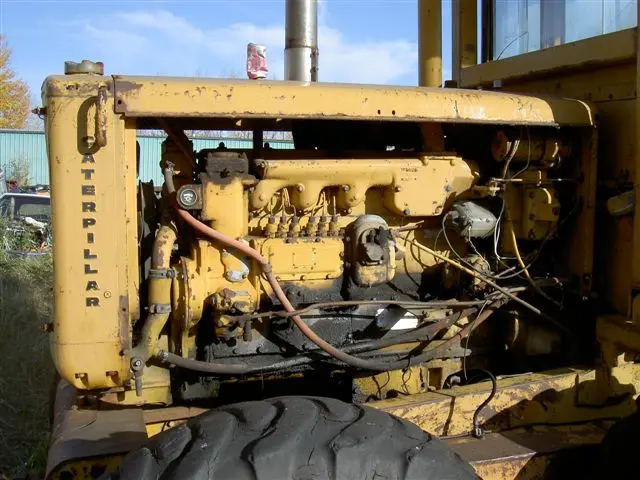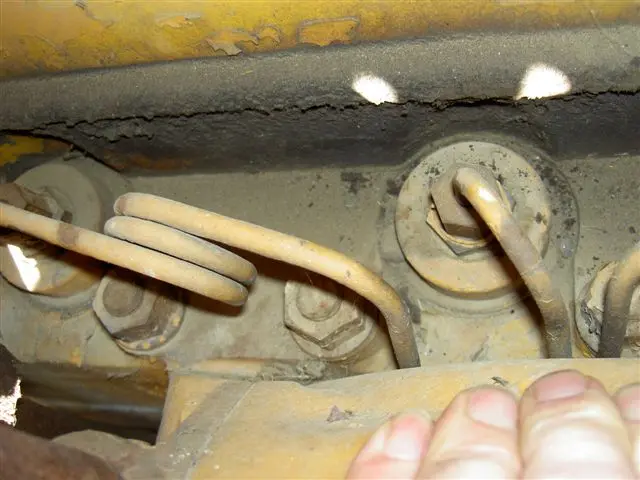Yes, the 14B 64C418 is a 1959 model.......the 64C series was only produced in 1959 and 1960. D333 engine.
If it has been sitting that long the first thing to do is crack all the various oil containing compartment drain plugs and drain any water that has accumulated.
Not a good idea to tow start until you know the engine will roll over and all the valves are free or you could bust something.
There isn't much access to bar the engine over but you could try prying the flywheel ring gear through the direct start access cover.
Filling coolant is not critical, just fill until you can see it in the upper radiator tank.....check to see the level is sustained.
The D333 engine will not have a plate on the side of the injection pump for access to the rack like the old engines had. So you might want to simply remove the precleaner on the air breather stack and have a piece of plywood or board that you can clap over it to smother the engine if it wants to run away. Once you're pretty confident it's OK, then put the precleaner cap back on.
If you can bar it over or get a socket on the crankshaft pulley bolt, or a wrench on the PTO shaft that runs forward under the cab (I believe it would have one there) and turn it through a few times, you would probably be OK to try to pull start it.
Not sure which pony motor that one had, but there were some that weren't much to write home about, along about that time. If there's a problem with the pony beyond the common fuel and spark problems, it might be a lot cheaper to install a starter on the diesel.
One problem was the design that had the pony motor sharing the diesel oil supply. There was a field conversion kit to go back to a separate oil sump on those, so maybe most of them got done. Beyond that, there probably isn't much to be done about the basic pony design other than to change oil regularly etc. They were called "buzz bombs" with some good reason.
CC, It would have that side mounted starting engine and yes I have changed lots of them over to the separate oil system at the dealer and the late D311 & D330 & and in this case the D333 were all the same type side mounted engine.That was a poor idea by Cat to use the dirty diesel oil in the starting engine and the life of them was really extended by separating the oil system so they had their own system. The little later ones came from the factory with the separate oil system on them after Cat found their mistake I guess.
Thank you everyone, ...it's moving!
The engine oil drain is one plug I feel confident about knowing where to look so will begin checking there for water first and then search for more oil drain plugs to drain water.
At present we have about an inch movement back and forth with a 3 foot bar on the flywheel through the direct start access cover on the right side. It seems softer to move one way more than the other. After about 6 times moving it back and forth I decided to stop thinking it may be wise to apply a liquid loosening agent at areas (if accessable) where it is sticking. I see covers on the top of the engine, is that an access point to the valves?
Hope to get a socket or wrench on the crankshaft today for more leverage.
I do see what I believe to be a side cover on this injector pump (pump is mounted on the right side of the engine with the fuel lines in a row coming out the top)
The starting engine looks to be mounted at the top with a cylinder pointing out each side. I noticed a large tube that could be connecting the oils. There is a seperate dip stick for the starting motor but the oil looks like the same.
Thank you everyone, ...it's moving!
The engine oil drain is one plug I feel confident about knowing where to look so will begin checking there for water first and then search for more oil drain plugs to drain water.
At present we have about an inch movement back and forth with a 3 foot bar on the flywheel through the direct start access cover on the right side. It seems softer to move one way more than the other. After about 6 times moving it back and forth I decided to stop thinking it may be wise to apply a liquid loosening agent at areas (if accessable) where it is sticking. I see covers on the top of the engine, is that an access point to the valves?
Hope to get a socket or wrench on the crankshaft today for more leverage.
I do see what I believe to be a side cover on this injector pump (pump is mounted on the right side of the engine with the fuel lines in a row coming out the top)
The starting engine looks to be mounted at the top with a cylinder pointing out each side. I noticed a large tube that could be connecting the oils. There is a seperate dip stick for the starting motor but the oil looks like the same.
OK, in checking closer the 64C (gasoline start) and the 78E (direct electric start) are the last of the D318 engines.....so yes there is a side cover on the fuel injection pump housing.
If I'm reading the rack setting manual right this is a "hot rod" model with turbocharger....140 hp with fan.....148 hp without....at 1800 rpm full load.
That unit will also have the oil clutch....with the connecting tube from bell housing to main engine sump (uses engine oil).
The pony is still a separate sump.



Thank you again, no worries on the indentity miss-match. I'm very grateful for your help. Photos are better than my descriptions and if I did it correct there should be 3 attached below.
Yes, left and right as when sitting in the operators seat facing front. There is a turbo charger on the left. The injector pump is on the right. The pony motor controls and pony exhaust running through the diesel motor intake on the right.
When I was looking for the flywheel ring gear access I had first opened a cover on the left and saw what I now understand would be the "oil clutch" assembly. The large tube from the main engine sump to the bell housing is easy to spot on the left.
I can see the injector hold down nut visible below the line connector nut (if the photos work and this is the same as described.) Is it wise to leave the injectors alone and keep prying the engine back and forth, or get something in there first to help soften up what ever has it binding? A friend was telling me that we could scar the cylinder walls and I'd like to make the right decision the first time. Another concern I'm thinking about is the availability and cost of replacing the seals for the injectors.
Considering building a box end tool to get onto the cranshaft nut at the rear as the sockets we have will not pass through the opening at the rear below the radiator,and no wrench large enough is available yet. There is a drum of sorts on the front of the transmission with a nut in the center as well. Could this be the (pto shaft) other option for turning the crankshaft?
Seals for the injectors are no problem and readily available from Cat.
Injector removal is still your best bet to get lube or penetrant into the cylinders.
The pto shaft is the upper shaft straight through in line with main engine crankshaft.
Yes, it would be possible to turn the engine using the large nut on the brake drum. The transmission/speed selector gear set is constant mesh so with trans in neutral, range in high or low and clutch engaged you should be able to turn main engine.
Depending on how you are doing with rotation of the crank it may be wise to pull the valve covers and check to see that all the valves are free.
Thank you again, no worries on the indentity miss-match. I'm very grateful for your help. Photos are better than my descriptions and if I did it correct there should be 3 attached below.
Yes, left and right as when sitting in the operators seat facing front. There is a turbo charger on the left. The injector pump is on the right. The pony motor controls and pony exhaust running through the diesel motor intake on the right.
When I was looking for the flywheel ring gear access I had first opened a cover on the left and saw what I now understand would be the "oil clutch" assembly. The large tube from the main engine sump to the bell housing is easy to spot on the left.
I can see the injector hold down nut visible below the line connector nut (if the photos work and this is the same as described.) Is it wise to leave the injectors alone and keep prying the engine back and forth, or get something in there first to help soften up what ever has it binding? A friend was telling me that we could scar the cylinder walls and I'd like to make the right decision the first time. Another concern I'm thinking about is the availability and cost of replacing the seals for the injectors.
Considering building a box end tool to get onto the cranshaft nut at the rear as the sockets we have will not pass through the opening at the rear below the radiator,and no wrench large enough is available yet. There is a drum of sorts on the front of the transmission with a nut in the center as well. Could this be the (pto shaft) other option for turning the crankshaft?